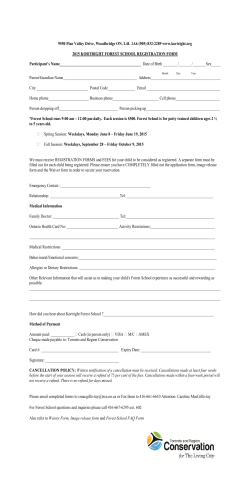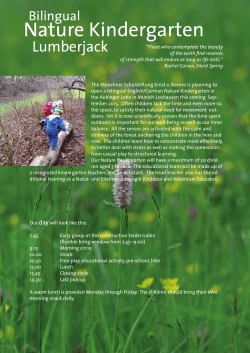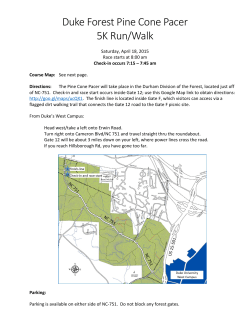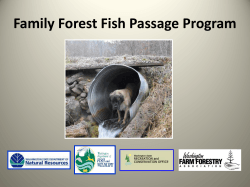
Untitled
Rearing of Cinta Senese pigs in oak and chestnut stands in central Tuscany - Proposal of a field survey method to estimate type and intensity of the damage Grifoni F., Gonnelli V., Fabbio G., Benvenuti C. in Audiot A. (ed.), Casabianca F. (ed.), Monin G. (ed.). 5. International Symposium on the Mediterranean Pig Zaragoza : CIHEAM Options Méditerranéennes : Série A. Séminaires Méditerranéens; n. 76 2007 pages 119-122 Article available on lin e / Article dispon ible en lign e à l’adresse : -------------------------------------------------------------------------------------------------------------------------------------------------------------------------http://om.ciheam.org/article.php?IDPDF=800570 -------------------------------------------------------------------------------------------------------------------------------------------------------------------------To cite th is article / Pou r citer cet article -------------------------------------------------------------------------------------------------------------------------------------------------------------------------Grifoni F., Gonnelli V., Fabbio G., Benvenuti C. Rearin g of Cin ta Sen ese pigs in oak an d ch estn u t stan ds in cen tral Tu scan y - Proposal of a field su rvey meth od to estimate type an d in ten sity of th e damage. In : Audiot A. (ed.), Casabianca F. (ed.), Monin G. (ed.). 5. International Symposium on the Mediterranean Pig . Zaragoza : CIHEAM, 2007. p. 119-122 (Options Méditerranéennes : Série A. Séminaires Méditerranéens; n. 76) -------------------------------------------------------------------------------------------------------------------------------------------------------------------------- http://www.ciheam.org/ http://om.ciheam.org/ Rearing of Cinta Senese pigs in oak and chestnut stands in central Tuscany – Proposal of a field survey method to estimate type and intensity of the damage F. Grifoni*, V. Gonnelli*, G. Fabbio** and C. Benvenuti** *Istituto Professionale per l’Agricoltura e l’Ambiente "Camaiti", 52036 Pieve S. Stefano (AR), Italy **CRA – Istituto Sperimentale per la Selvicoltura, 52100 Arezzo, Italy SUMMARY – The local pig breed Cinta Senese is reared in oak and chestnut forests. According to the forest law in Tuscany, grazing under the forest cover is allowed if no damage is produced to the soil and vegetation. Three different rearing systems were compared: (i) extensive grazing in the forest for the whole year (1 to 3 animal units [a.u.] per hectare); (ii) extensive grazing in the forest and on complementary agricultural crops for the whole year (0.22 a.u. per hectare); (iii) extensive grazing in the forest during the fruit fall period only (20 a.u. per hectare per 11 days/year). Damages related to each type were as follows: (i) high incidence of damage to the soil, to the vegetation, trees included; (ii) evidence of damage to the soil and to the forest floor, no damage to the trees; (iii) only a minor impact on the forest floor. Keywords: Animal rearing and forest, damage assessment method, oak and chestnut Tuscan stands, Cinta Senese pigs. RESUME – "Elevage de porcins Cinta Senese dans des forêts de chênes et châtaigniers dans le centre de la Toscana. Proposition d’une méthode d’étude sur terrain pour estimer le type et l’intensité des dégâts". La Cinta Senese pâture dans des bois de chênes et de châtaigniers. La loi forestière toscane permet le pâturage dans la forêt s’il n’endommage pas le sol et la végétation. On propose une méthodologie pour évaluer les dommages du pâturage. On analyse trois systèmes d’élevage différents: (i) pâturage en forêt pendant toute l’année (1-3 tête / hectare); (ii) pâturage en forêt et sur surface agricole pendant toute l’année (0,22 tête / hectare); (iii) pâturage en forêt pendant la période de chute des fruits seulement (20 tête / hectare pendant 11 jours); Dans le type (i) après 1 année environ, on a constaté des dégâts importants sur la végétation, le sol et les arbres. Dans le type (ii), après la même période, on a constaté des dégâts sur le sol et la végétation, mais pas sur les arbres. Dans le type (iii), après la consommation des fruits (11 jours), les dégâts sont très légers. Mots-clés : Pâturage en forêt, méthodologie d’évaluation des dégâts au pâturage, bois toscans de chênes et châtaigniers, race porcine Cinta Senese. Introduction The Cinta Senese is a local breed of pig being reared extensively since the Middle Ages, especially in the province of Siena (central Tuscany). A renewed attention is shown for this breed at present. Oak and chestnut stands were one of the typical rearing environments of this breed. The forest, before devoted mainly to firewood and timber production and used also to the purpose of livestock husbandry in the densely populated rural areas, is assuming nowadays prevailing protective, aesthetical, recreational functions (Fabbio et al., 2004), which clash with the traditional use, at least where the scenic value of the remnant forest in the landscape is as high as in the hilly environment in Tuscany. The implementation of traditional uses, as the rearing of Cinta Senese pigs under the forest cover, needs therefore a careful planning in order to be compatible with the other functions prevailing nowadays. The historical management of Mediterranean forests, the use for livestock farming included, was the main driver of the transformation (Clèment, 1999), erosion, fragmentation and simplification of forest structure. The local communities too, concerned with the multiple productive of forests but also to maintain the natural resource in a compatible (i.e. available to the use) condition (Laganà, 1990; Massai, 1998), experienced empirical rules of sustainable management in order to preserve the forest quality, even on simplified or better targeted structures (e.g. the oak stands especially devoted to pig rearing in Tuscany). Given this background, the Italian legislation on the subject-matter considered both the productive and protective (hydrogeological) facets since the first national law dated 1923 (De Montgolfier et al., Options Méditerranéennes, Series A, No. 76 119 2002). The sense and purpose of these regulations are still valid, because soil protection against erosion and water management, in Italy, are considered at present the main goals to be pursued by an effective forest cover (De Montgolfier et al., 2002). The regional Law in Tuscany allows the practice of grazing on the forest floor, under the limitation of no damage occurrence to the soil and vegetation. The goal of this research trial was the identification of a sustainable rearing with Cinta Senese under the forest cover, i.e. an use compatible with forest conservation and in accordance with current law regulations. To this purpose, an easily enforceable methodology of field survey to recognize the first occurrence of damage was set up and tested. Materials and methods Types and extent of damages were highlighted by the comparison of the area before and after the occurrence of grazing. Plots (400 m2) were sampled into different forest conditions (site-index, canopy cover, tree species composition and development, etc.). Field surveys included: (i) damages to root branches of tree species; and (ii) desirability to animals of each species. Permanent micro-plots (2x2 m) were then established to estimate damages occurring to ground vegetation and soil. The flora before and after the grazing action was surveyed. At the purpose of making the estimate as precise as possible, a grid 50x50 cm was established on each micro-plot. The following types of damage were considered: (i) Specific coverage reduction; (ii) Partial damages (such as browsing of leaves and apical buds); (iii) Uprooting following digging around stem base; (iv) Mechanical breaking off of shrubs (mostly) due to animals ploughing through; (v) Decrease of herbaceous and shrubby cover; (vi) Altered forest floor (litter movement and ploughing up of the upper humus layer); (vii) Breaking of top soil layers by creation of pathways (different levels of disturbance); (viii) Percentage area concerned with humus layer movement; (ix) Digging: down to 5 cm; 5-10 cm; more than 10 cm. The soil trampling, i.e. and additional, heavy soil disturbance is not included in this determination. Three sites in the neighbourhood of Siena, each one managed according to a different rearing technique, were concerned with the damage survey: (i) Extensive grazing under the forest cover (Quercus pubescens Willd. and Quercus cerris L. forest being the unique rearing environment) over all the year with 1 and 3 animal units/hectare (2001); 14 hectares were concerned within each thesis and an integrative feeding was employed. The surveys were undertaken on 4 plots 400 m2 and on 18 micro-plots 2x2 m wide. (ii) Extensive grazing under the forest cover (Quercus ilex L. and Castanea sativa Miller forest) and on complementary agricultural crops over all the year with 0.22 animal units/hectare (2003); total forest area 470 hectares, agricultural crops (rangeland, sown land and meadows) 80 hectares. Employed an integrative feeding. Surveys established on 3 plots 400 m2 and 12 micro-plots 2x2 m wide. (iii) Extensive grazing under the forest cover (Castanea sativa Miller) only during the fruit fall period (11 days) with 20 animal units/hectare (2003). Area concerned 0.5 hectare, no integrative feeding supplied. Surveys undertaken on 1 plot 400 m2 and 3 micro-plots 2x2 m wide. Results and discussion The recently published papers dealing with the historical and current facets of Cinta Senese rearing may be usefully implemented with the analysis and discussion on the compatible use of forest resources within the rearing environment of pigs. A few elements of the above described methodology of damage survey are reported here. 120 Options Méditerranéennes, Series A, No. 76 Loss of vegetation cover. This type of damage occurs for herbaceous and shrub layers i.e. the vegetation living on the forest floor. As highlighted in Table 1, the damage to the forest ecosystem is heavy in the type (A) with 3 a.u./hectare and also with the minor number of a.u. the damage is close to 40%. The damage is less important in the type (B) but, in spite of the low stocking rate, the disturbance is still noteworthy. The lowest damage has been measured in the type (C), to highlight how an elevated stocking rate for a very limited time is able to avoid damages. The reduction of biomass close to the ground may be considered a positive result into Mediterranean forest ecosystems due to the high risk of fires, but the concomitant minor vegetation cover determines the less efficient interception of rain and enhances its erosive action on slopes and steep soils. Table 1. Damage level in the three rearing types tested Rearing under the forest cover over the whole year (A) Rearing under the forest cover and complementary agricultural crops (B) Rearing under the forest cover limited to the fruit fall (C) 3 a.u. 1 a.u. Holm oak Chestnut Chestnut Decrease of veg. cover (%) 56.4 38.1 21.5 32.5 2.0 Altered top soil layers (%) 76.1 72.3 94.4 91.2 Digged soil area (%) 43.8 4.0 1.9 35.0 4.0 Excavation of roots (% of plants) Pub. oak Holm oak Turkey oak Chestnut 95.4 100.0 0 – 40.0 92.8 0 – – 0 – – – – – 0 – – – 0 Bitten plants (%) Pub. oak Holm oak Turkey oak Chestnut 54.0 100.0 0 – 0 85.0 0 – – 0 – – – – – 0 – – – 0 Percentage of altered soil. This damage is very high in the type (B) where it is close to 100%, in spite of the low number of a.u. and the availability of complementary areas outside the forest. A reason may be found in the long lasting presence of animals inside the forest; in the holm oak forest a further reason may depend on the long fruit fall period (September-March), which enhances the digging action of the animals aiming at finding out the acorns on the forest floor. Elevated damages were observed also in type (A) independently of the number of animal units; the permanence time being the major stress factor driving the change of top soil properties. The heavy number of animals for a short period as in type (C) drastically reduces the soil alteration. Percentage of digged soil. Damage is much higher in type (A) under the thesis of 3 a.u./hectare as a function of the more elevated competition. Damage is still high in the type (B), in spite of the low stocking rate, under the chestnut cover. This result is not explained by the trial at present. The reduced permanence of animals in type (C) affects positively also this type of damage. Excavation of root branches. Measured damages were very high in the type (A) for both the oak species. A remarkable difference between holm oak and pubescent oak is given by the variation of a.u.; the damage is steady for holm oak, whilst it drops for pubescent oak as a function of the less intensive stocking rate. Further investigations should be addressed to the purpose, given the presumably higher attraction exerted by holm oak roots. No damages were measured on the Turkey oak root branches independently of the number of a.u. The influence of boundaries (fencing) to the grazing area could explain why damages are much more limited in type (B) for holm oak too; here, animals were free to move towards the neighbouring agricultural crops all the rearing period long. The more limited number of a.u. per unit area was also significant. No damages were observed in type (C), where the result is attributable to the very short permanence period of animals inside the forest. Options Méditerranéennes, Series A, No. 76 121 Bite to root branches of forest trees. The evidence of this type of damage follows the same pattern of the previous one, highlighting a further shortcoming of the rearing system undertaken for a long period (the whole year) exclusively under the forest cover. The direct damage to tree tissues makes them, as a matter of fact, more sensitive to parasites and to any adverse climatic events or biological constraints. The different damage intensity on each tree species surveyed in this experience confirms the preferential behaviour of animals already monitored in other experimental trials on the subjectmatter (Bjerke, 1959). Conclusions The proposed method to estimate different, concurrent types of damage to forest soil and vegetation due to pig rearing under the forest cover, showed the evidence that a limited permanence in time of animals makes the impact not significant both on vegetation, soil properties and directly on tree tissues. The grazing during the fruit fall period only results in the more compatible use of forest resource. The contemporary availability of open spaces close to the forest makes the disturbance less important than the full use of forest, but produces, already after one year, noticeable damages to the forest floor and top soil layers. Direct damages to tree species vice versa occur when rearing is bounded to the forest environment only. The use of forest is historically a key issue of Cinta Senese pigs rearing in the area where the production originated. The findings from the undertaken trials give the evidence that a correct planning of available resources is fundamental to the sustainability of the production. The forest is and remains a very sensitive environment naturally showing a very limited stocking rate in terms of feeding animals, independently of the high biomass stocked. The forest fruit production, limited to the fall season, is the main feeding resource and it should be harvested at the time of its occurrence, avoiding the permanence of animals out of this time. The concurrent presence of agricultural crops is essential to establish an economically feasible production. The early warning of damages is a basic tool to make the rearing possible without compromising the ecological value of the natural resources invested in the production. Further investigations are needed on soil trampling due to grazing, this item not being considered here. Acknowledgements This study was supported by grant from ARSIA (Tuscany Region). The authors wish to thank the managerial and technical staff of "Azienda Agraria Bezzini", "Tenuta Arceno Us. Inc." of Siena and "Azienda Agricola Ciampoli" of Montieri (Gr). References Bjerke, S. (1959). Om svin og skov Dansk Skovforen.Tidsskr., 10: 529-540. Clément, V. (1999). Les milieux forestiers méditerranéens. In: Les milieux forestiers, aspects géographiques. Dossiers des Images Economiques du Monde, Dossier 25, SEDES: 182-202. De Montgolfier, J. et al. (2002). Les espaces boisés méditerranéens – situation et perspectives. PNUE – Plan Bleu, Diffusion Economica, Paris. Fabbio, G., Benvenuti, C., Grifoni, F. and Gonnelli, V. (2004). Utilizzazione delle risorse del bosco. In: La Cinta Senese gestione attuale di una razza antica. ARSIA, Firenze, pp. 141-173. Laganà, N. (1990). Limano: pagine di storia seicentesca. Maria Pacini Fazzi Ed., Lucca. Massai, S. (1998). La selva del lago. Protagon Editori Toscani. 122 Options Méditerranéennes, Series A, No. 76
© Copyright 2025









